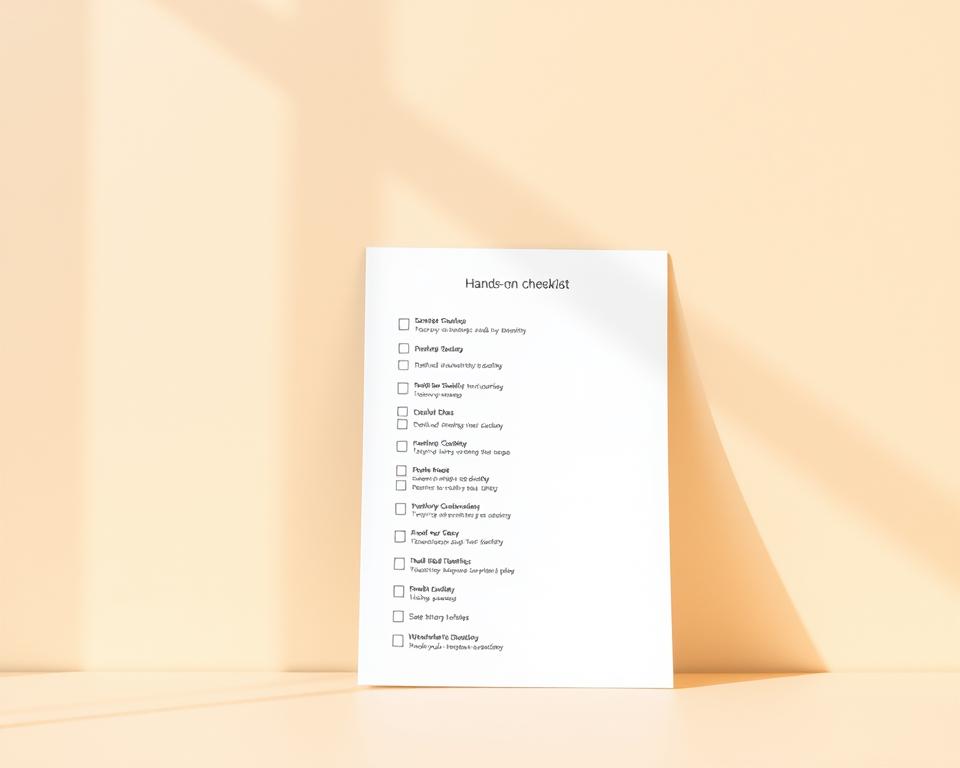Anuncios
¿Alguna vez te preguntaste si unos pequeños movimientos podrían cambiar la forma en que manejas un día agitado? No necesitas una transformación completa de tu vida para sentirte más estable. Hábitos sencillos, como cinco o diez minutos de respiración concentrada o una caminata rápida al día, pueden cambiar la respuesta de tu cuerpo y mejorar tu estado de ánimo.
Piense en esta guía como un plan amistoso Para usar tu tiempo sabiamente. Encontrarás prácticas rápidas que se adaptan al trabajo, la familia y los recados. Pequeños pasos, repetidos, dan resultados reales para tu salud mental y general.
Te mostraremos maneras prácticas de dividir las tareas grandes en acciones breves, planificar breves descansos e incorporar movimiento y nutrición en rutinas intensas. Estas técnicas te ayudarán a actuar antes de que la presión aumente y a mantener la energía estable a lo largo del día.
Conclusiones clave
- Movimientos cortos diarios y pausas para respirar pueden mejorar el estado de ánimo rápidamente.
- 150 minutos de ejercicio moderado por semana fomenta la resiliencia.
- Dividir las tareas en pasos hace que el tiempo parezca más manejable.
- Las comidas equilibradas y los tiempos de descanso planificados estabilizan la energía.
- Técnicas sencillas le ayudarán a detectar y aliviar la presión de forma temprana.
Entiende el estrés hoy: qué es y cómo afecta tu cuerpo y mente
Comience por reconocer la forma en que su cuerpo entra en acción cuando la vida se siente abrumadora. Esta alarma incorporada te ayuda a reaccionar ante los desafíos, pero cuando permanece activada puede agotar tu energía y afectar tu salud.
La respuesta al estrés y los signos físicos comunes
La respuesta al estrés Activa las hormonas que preparan el cuerpo para actuar. Puedes notar dolores de cabeza, rigidez muscular, taquicardia o malestar estomacal.
Estas son señales físicas que envía el sistema nervioso cuando la presión persiste. Con el tiempo, el estrés crónico puede afectar el sueño, el sistema inmunitario y la salud en general.
Señales conductuales y emocionales que no debes ignorar
Cuando tu mente reacciona, podrías tener dificultad para concentrarte, olvidar cosas, sentirte irritable o preocuparte constantemente. El sueño y el apetito pueden cambiar, y algunas personas recurren a hábitos poco saludables para sobrellevarlo.
“Detecta patrones de forma temprana: detectar señales te permite actuar antes de que las cosas empeoren”.
- Dificultad para concentrarse o lapsus de memoria
- Sentirse abrumado o enfadarse rápidamente
- Cambios en el sueño o la alimentación y aumento de la ansiedad.
Diferentes situaciones (trabajo, dinero o relaciones) crean desencadenantes únicos. Para obtener información clínica clara sobre estas reacciones, consulte Lo que dicen las fuentes clínicas.
Detecta tus factores estresantes y patrones personales antes de que se agraven
Comience un breve hábito de registrar lo que precede a sus reacciones y las señales que le siguen. Un diario pequeño y consistente te ayuda a ver si un problema importante o muchos pequeños detalles se acumulan. A lo largo de una o dos semanas, las notas hacen evidentes los patrones.
Realice un seguimiento de los factores desencadenantes del momento con un diario de estrés simple
Anota rápidamente en tu teléfono o en una libreta. Escribe tres líneas: Desencadenante → Señal corporal/anímica → Qué hice después. Esto permite que las entradas sean breves y fáciles de usar.
Registra la hora, lo que sucedió (un correo electrónico difícil en el trabajo, un retraso en el viaje, una agenda apretada) y cómo reaccionó tu cuerpo: tensión en los hombros, dolor de cabeza o pensamientos acelerados. Agrega contexto, como el sueño, las comidas y la cafeína.
- Captura desencadenantes y emociones en tiempo real para que los patrones sean honestos.
- Anote los eventos laborales o de vida que le causan estrés y el momento del día en que ocurren.
- Utilice la plantilla de tres líneas para actuar, no para pensar demasiado.
“Las notas pequeñas conducen a decisiones más importantes: puedes cambiar notificaciones, reordenar tareas o planificar descansos en función de lo que aprendas”.
Usa lo que encuentres para priorizar las soluciones. Si se acumulan muchos problemas menores por la tarde, adelanta el trabajo clave o establece un límite para las notificaciones. Estos registros sencillos te guiarán en la toma de decisiones prácticas para una mejor salud mental y un mejor equilibrio laboral.
Utilice las 4 A para gestionar situaciones estresantes con confianza
Este marco rápido le ayudará a elegir cuándo cambiar una situación y cuándo modificar su respuesta. Cada “A” proporciona una forma práctica de actuar en el trabajo, en casa o en la vida diaria.

Evita: reduce la presión innecesaria en tu día
Recortar las demandas de bajo valor. Di no a las solicitudes que te quitan tiempo, agrupan recados y silencian alertas no esenciales.
Crear una regla: si una tarea no es esencial, aplazarla, delegarla o eliminarla.
Alterar: comunicar necesidades y establecer expectativas
Habla con claridad y amabilidad. Indica lo que necesitas, propone opciones y establece plazos realistas en el trabajo o con la familia.
Esto evita que los pequeños problemas se conviertan en bolas de nieve.
Adaptarse: replantear, ajustar los estándares y practicar la gratitud
Amplía tu visión al panorama general y relaja los estándares perfeccionistas.
Prueba una nota de gratitud diaria para cambiar tu forma de ver las cosas y proteger tu energía.
Aceptar: dejar ir, perdonar y centrarse en lo que puedes controlar.
Algunas cosas no cambiarán. Elige cómo respondes, deja atrás los rencores y comparte tus sentimientos con personas de confianza.
“Utilice la lista de verificación de las 4 A cuando una nueva situación comience a sentirse pesada: le ayudará a actuar con calma y claridad”.
Mueva su cuerpo para aliviar el estrés y tener mejor energía.
Moverse un poco cada día ayuda a mantener estable la energía y a manejar mejor los momentos agitados.
Los objetivos de actividad semanales son fáciles de establecer: Intenta realizar 150 minutos de ejercicio moderado o 75 minutos de trabajo intenso a la semana. Empieza poco a poco con tres caminatas rápidas de 10 minutos y ve aumentando a partir de ahí.
Micromovimientos que encajan en una agenda apretada
Incorpora acciones cortas a tu día. Sube las escaleras, aparca más lejos, estira dos minutos entre reuniones o baila.
Cómo el movimiento favorece el estado de ánimo, la concentración y la resiliencia
El ejercicio regular libera endorfinas que mejoran el estado de ánimo y agudizan la atención. Además, fortalece la salud física, lo que te permite recuperarte más rápido cuando la vida se vuelve ajetreada.
Hazlo sostenible: objetivos, disfrute y responsabilidad
Crea un plan simple para controlar el estrés con movimiento: establece bloques en tu calendario, elige una opción alternativa en interiores y usa una regla de cinco minutos para reducir la fricción.
- Adapte la actividad a su energía: Camina en los días bajos, haz intervalos cuando necesites un impulso.
- Elige la alegría: Elige actividades que te gusten e invita a un amigo o únete a una clase para mantenerte responsable.
- Los pequeños bocadillos suman: Las ráfagas breves reducen la tensión y ayudan a dormir mejor.
“El movimiento corto y regular puede cambiar cómo te sientes a lo largo del día y proteger la salud a largo plazo”.
Calma tu sistema nervioso con técnicas de relajación rápida
Una práctica breve y regular puede cambiar tu sistema nervioso de reactivo a tranquilo en cuestión de minutos. Estas son formas prácticas de reducir la tensión cuando la vida se siente plena.
Respiración profunda que puedes hacer en cualquier lugar
Realiza este reinicio: Siéntese cómodamente, cierre los ojos, imagine un lugar tranquilo y respire lentamente durante 5 a 10 minutos.
Cuenta cuatro al inhalar, retén uno y suelta seis. Repite hasta que sientas la respiración regular. Esta sencilla meditación facilita un rápido alivio del estrés y te ayuda a reaccionar con firmeza en momentos de tensión.
Relajación muscular progresiva para liberar la tensión.
Trabaja desde los dedos de los pies hasta la frente. Tensa cada grupo durante cinco segundos, luego suéltalo y nota la liberación.
Muévete por las pantorrillas, los muslos, el abdomen, las manos, los hombros y la cara. Esta práctica ayuda al cuerpo a eliminar la tensión acumulada y mejora el sueño si se realiza antes de acostarse.
Imágenes guiadas y atención plena en momentos cotidianos
Imagina las olas del mar o un bosque tranquilo durante dos a cinco minutos. Combínalo con una ducha consciente, un descanso para tomar un café o una caminata concentrada.
- Elige una técnica que se ajuste a tu horario.
- Utilice una señal telefónica o una pequeña tarjeta de práctica para actuar rápidamente en un momento tenso.
- Combine un método favorito con la hora de acostarse para aumentar el alivio del estrés a largo plazo.
“Las rutinas cortas enseñan a tu cuerpo y a tu mente cómo tranquilizarse rápidamente: practica un poco cada día”.
Fundamentos del sueño y la nutrición que te ayudan a manejar el estrés
Una hora fija para acostarse y una elección de alimentos equilibrados forman la columna vertebral de la resiliencia diaria. El sueño y la alimentación son cosas sencillas que puedes modificar para proteger tu salud mental y física.

Hábitos de sueño que restauran tu mente y cuerpo
Establezca una ventana de sueño regular. Acuéstese y levántese a la misma hora la mayoría de los días para ayudar a su cuerpo a restablecerse.
Crea una rutina breve para relajarte: luces tenues, sin pantallas durante 30 a 60 minutos y una rutina relajante. Estas pequeñas reglas mejoran el descanso profundo y la concentración matutina.
Qué comer para equilibrar la energía, el estado de ánimo y las hormonas
Elija productos coloridos, cereales integrales, proteínas magras y fuentes de omega-3 como salmón o nueces.
Planifique refrigerios sencillos (yogur con bayas o hummus y verduras) para evitar bajones de energía que hagan que el día se sienta más pesado.
Tenga cuidado con la cafeína, el alcohol y la nicotina.
Limite la cafeína tardía y las comidas copiosas a altas horas de la noche que causan subidas y bajadas de ánimo. El alcohol puede ofrecer alivio, pero después actúa como depresor.
La nicotina alimenta los antojos y el sueño intranquilo, lo que puede empeorar la ansiedad y la depresión con el tiempo.
“Considere el sueño y la alimentación como pilares diarios: cuando estos son estables, otros cambios se vuelven más fáciles”.
- Hidrátate y protege un horario de dormir consistente.
- Utilice los alimentos para estabilizar la energía y el estado de ánimo a lo largo de su vida.
- Considere estas rutinas como parte de su plan de salud a largo plazo.
Protege tu tiempo: límites, prioridades y ritmos de trabajo más inteligentes
Reservar pequeños momentos de tu día te permitirá concentrarte en trabajo de alto impacto sin quedar atrapado en un trabajo ininterrumpido. Trate el tiempo como un recurso limitado y diseñe su agenda de manera que las cosas importantes obtengan su mejor energía.
Prioriza lo que importa y divide las tareas grandes en pasos
Crea una breve lista de prioridades diarias Con tres elementos principales. Divide cada tarea importante en listas de verificación de una página o pasos de 20 minutos para que los problemas parezcan manejables en lugar de enormes.
Decir no y delegar sin culpa
Establece límites claros. Si tienes mucho trabajo, di que no o ofrece un momento para más tarde. Delega tareas que otros puedan hacer y libera tu agenda para tareas de mayor valor.
Diseña tu día: agrupación, buffers y descansos de recuperación
Agrupa tareas similares (correo electrónico, llamadas, administración) en bloques específicos. Deja intervalos de 10 a 15 minutos entre reuniones para que puedas reiniciar.
- Establezca pausas breves para recuperarse: cinco minutos para estar de pie, respirar o salir al exterior.
- Elija una ventana de planificación (final del día) para trazar las tres tareas principales del día siguiente.
- Proteja los bloqueos de trabajo profundo silenciando las notificaciones y utilizando retenciones de calendario.
“Pequeñas reglas para tu calendario hacen que tu jornada laboral fluya y ayudan a reducir el estrés”.
Usa técnicas sencillas (listas de verificación, plantillas y reglas de calendario) para ahorrar tiempo. Estas prácticas estrategias te ayudan a reducir el estrés y a que tu vida y tu trabajo avancen con menos fricciones.
Consejos para manejar el estrés
Apóyese en conexiones simples y reales que calmen su cuerpo y mejoren su estado de ánimo.
Apóyate en personas que te ayuden a sentirte comprendido
Haz una lista corta de dos a cuatro personas (amigos, un ser querido o familiares) que te hagan sentir visto.
Programe breves reuniones: un mensaje de texto, una caminata de diez minutos o una llamada rápida. Estos pequeños gestos generan un apoyo constante y reducen el aislamiento.
Contacta pronto, no solo en tiempos de crisis. Una frase sencilla como: "Estoy estresado por X; ¿puedo hablarlo?" inicia una conversación útil.
Practica un diálogo interno positivo y mantén tu sentido del humor.
Cambia las frases duras por otras más amables. Intenta decir: "Puedo ir paso a paso" en lugar de "No puedo con esto".
Aprovecha los momentos de relax para relajarte. Ríete con un amigo o mira un vídeo corto y divertido para cambiar tu estado de ánimo y aliviar la tensión.
- Crea una pequeña rutina: un mensaje de texto, una caminata o una llamada de 10 minutos cada semana.
- Utilice un guión de ejemplo para pedir ayuda en casa o en el trabajo para poder compartir cosas y gestionar el estrés de forma más efectiva.
- Observe cómo mantenerse conectado favorece su salud mental y evita que los días difíciles parezcan tan grandes.
“Hablar con alguien que te comprende puede cambiar la forma en que reacciona tu cuerpo y proteger tu salud mental”.
Conclusión
Termine convirtiendo estas ideas en una pequeña rutina diaria que realmente pueda mantener.
Elige una pequeña acción cada día — De cinco a diez minutos de respiración, una caminata corta o un estiramiento breve — y repítelo. Intenta realizar 150 minutos de actividad semanal y un periodo de sueño regular para proteger tu energía y tu salud mental.
Lleva una lista de verificación de bolsillo: muévete, respira, energízate, descansa, conecta. Usa las 4 A para decidir qué cambiar y qué aceptar cuando la presión aumenta. Cuando notes las primeras señales de estrés, elige una técnica sencilla y ponla en práctica en el momento.
Descubrirás que el progreso supera a la perfección. Estos métodos, respaldados por la evidencia, se adaptan a la vida real y te ayudan a afrontar un día ajetreado con más calma, mayor concentración y una mejor salud mental a largo plazo.
Preguntas frecuentes
¿Qué acciones sencillas puedo realizar ahora mismo para traer calma a una vida ocupada?
Empieza con un pequeño cambio: respira profunda y lentamente tres veces, haz una pausa de 60 segundos para enumerar tres prioridades y muévete durante cinco minutos. Estos pequeños pasos reducen la respuesta de alarma de tu cuerpo, mejoran la concentración y te dan energía para afrontar la siguiente tarea sin sentirte abrumado.
¿Cómo se manifiesta físicamente la respuesta del cuerpo a la presión?
Podrías notar un ritmo cardíaco acelerado, respiración superficial, tensión muscular, dolor de cabeza o malestar estomacal. Estas son señales de que tu sistema nervioso ha entrado en un estado de alerta máxima. Prestar atención te ayudará a reaccionar con rapidez: usa la respiración o una caminata corta para calmar tu sistema.
¿Qué señales conductuales o emocionales no debo ignorar?
Esté atento a cambios en el sueño, el apetito, la irritabilidad, el abandono de actividades o la dificultad para concentrarse. Estos cambios suelen presentarse antes de problemas más graves, como la ansiedad o el bajo estado de ánimo. Los ajustes tempranos (hablar con alguien, ajustar las expectativas o programar la recuperación) pueden prevenir que la situación empeore.
¿Cómo puedo identificar mis desencadenantes personales antes de que se agraven?
Lleva un breve diario de estrés durante una semana: anota la situación, tu reacción y cómo la afrontaste. Surgirán patrones: tareas, personas o momentos del día específicos que aumentan tu tensión repetidamente. Una vez que conozcas los desencadenantes, podrás planificar estrategias específicas para reducir su impacto.
¿Qué son las “4 A” y cómo ayudan en situaciones estresantes?
Las 4 A son Evitar, Modificar, Adaptar y Aceptar. Evitar reduce la presión innecesaria, Modificar implica comunicar o cambiar tareas, Adaptar significa replantear o ajustar los estándares, y Aceptar se centra en dejar ir lo que está fuera de tu control. Úsalas para elegir la respuesta más práctica en cada situación.
¿Cómo puedo reducir la presión innecesaria en una agenda ocupada?
Elimina las tareas que aportan poco valor, delega cuando sea posible y crea márgenes de tiempo entre compromisos. Di no a las solicitudes adicionales que interfieren con tus prioridades. Estas decisiones protegen tu energía y reducen el riesgo de agotamiento.
¿Cuál es una forma eficaz de comunicar necesidades y establecer expectativas en el trabajo o en casa?
Sea claro y específico: describa la tarea, la fecha límite que puede cumplir y el apoyo que necesita. Use frases en primera persona para expresar límites y proponer alternativas. Los límites claros reducen los malentendidos y la sobrecarga crónica.
¿Cómo pueden ayudar el replanteamiento y la gratitud cuando las cosas parecen abrumadoras?
Replantear las cosas cambia tu perspectiva de la amenaza al desafío, lo que reduce la activación fisiológica. Observar una o dos cosas que aprecias cada día entrena tu cerebro para percibir lo positivo, mejorando el estado de ánimo y la resiliencia ante los problemas.
¿Cuándo debo practicar el dejar ir en lugar de intentar cambiar una situación?
Elige dejar ir cuando el problema esté fuera de tu control, ya sean eventos pasados o decisiones ajenas. Elige el cambio cuando tus acciones puedan influir significativamente en los resultados. Concentra tu energía en lo que produce resultados y acepta lo que no puedes solucionar.
¿Cuánta actividad semanal ayuda a mejorar la energía y el estado de ánimo?
Intenta realizar unos 150 minutos de actividad moderada a la semana, o periodos más cortos si tienes poco tiempo. Incluso sesiones intensas de 10 a 15 minutos suman y mejoran tu estado de ánimo, agudizan la concentración y te ayudan a desarrollar resiliencia ante las presiones diarias.
¿Qué micromovimientos sencillos puedo hacer durante un día repleto de actividades?
Haz elevaciones de pantorrillas de pie durante las llamadas, estiramientos de dos minutos entre reuniones, flexiones de escritorio o sube escaleras en lugar de usar el ascensor. Estos pequeños movimientos interrumpen el tiempo sedentario y reducen la tensión muscular.
¿Cómo el ejercicio regular favorece la claridad mental y la resiliencia?
El movimiento aumenta el flujo sanguíneo al cerebro, libera sustancias químicas que favorecen el estado de ánimo, mejora el sueño y reduce la intensidad de las alarmas del cuerpo. Con el tiempo, el ejercicio ayuda a recuperarse más rápido del estrés y a mantener la concentración bajo presión.
¿Cómo puedo mantener una rutina de ejercicios agradable y sostenible?
Elige actividades que te gusten, establece metas realistas y compite con otros para que se responsabilicen. Incorpora variedad a tu horario y registra tus pequeños logros para mantenerte motivado. Disfrutar de las cosas ayuda a mantener los hábitos.
¿Qué técnicas de relajación rápida calman rápidamente el sistema nervioso?
Prueba la respiración en caja (cuatro inhalaciones, cuatro retenciones, cuatro exhalaciones, cuatro retenciones), un escaneo muscular progresivo de 90 segundos o una breve visualización guiada centrada en los detalles sensoriales. Estos métodos reducen la frecuencia cardíaca y te ayudan a alcanzar la calma.
¿Cómo puedo hacer relajación muscular progresiva cuando sólo tengo unos minutos?
Tense cada grupo muscular principal durante cinco segundos, luego suéltelo y note la diferencia: comience con los hombros y el cuello, continúe con los brazos y luego con las piernas. Incluso un ciclo corto alivia la tensión corporal y mejora la atención.
¿Puede la atención plena encajar en los momentos cotidianos si tengo poco tiempo?
Sí. Presta atención plena a las tareas rutinarias: siente el agua mientras te lavas las manos, observa la respiración durante el trayecto al trabajo o concéntrate por completo en un bocado durante la comida. Estas miniprácticas reducen la reactividad y renuevan la concentración.
¿Qué hábitos a la hora de acostarse ayudan a recuperar la mente y el cuerpo?
Mantén un horario de sueño constante, relájate con actividades poco estimulantes, atenúa las luces una hora antes de acostarte y evita las pantallas cerca de la hora de dormir. Una breve rutina antes de dormir indica al cuerpo que se relaje y mejora la calidad del sueño.
¿Qué alimentos favorecen un estado de energía, un estado de ánimo y unas hormonas estables?
Prioriza los alimentos integrales: proteínas magras, cereales integrales, frutas, verduras, grasas saludables y fibra. Comer regularmente y comer bocadillos equilibrados previene los bajones de energía y los cambios de humor que dificultan la adaptación.
¿Cómo debo controlar la cafeína, el alcohol y la nicotina cuando me siento abrumado?
Limite la cafeína al final del día para proteger el sueño. Consuma alcohol con moderación; aunque parezca relajante, altera el sueño reparador y el estado de ánimo. Evite la nicotina; aumenta la excitación y puede empeorar la ansiedad. Pequeñas reducciones producen grandes mejoras en la recuperación.
¿Qué estrategias ayudan a proteger el tiempo y reducir la presión diaria?
Prioriza las tareas más importantes, agrupa trabajos similares, programa descansos y crea intervalos cortos entre compromisos. Estos ritmos evitan la sobrecarga y te mantienen productivo sin prisas constantes.
¿Cómo puedo decir no o delegar sin sentirme culpable?
Enfoca tu respuesta en prioridades: explica en qué te estás enfocando y ofrece un cronograma alternativo o a alguien que pueda ayudarte. Los límites claros y respetuosos preservan las relaciones y reducen el resentimiento.
¿Cuáles son formas prácticas de diseñar un día que apoye la recuperación?
Reserve tiempo para el trabajo concentrado, programe breves descansos y movimientos, proteja un período de relajación innegociable y limite las reuniones a las esenciales. Pequeños cambios estructurales mejoran la energía y reducen la sobrecarga.
¿En quién debo apoyarme cuando las emociones se sienten pesadas?
Contacta con personas que te escuchen sin juzgarte: amigos, familiares, mentores o un terapeuta. La conexión social reduce el aislamiento y te ayuda a replantear los problemas y a encontrar soluciones más rápidamente.
¿Cómo ayudan el diálogo interno positivo y el humor cuando aumentan las presiones?
El diálogo interno amable reduce los ciclos negativos que aumentan la preocupación, mientras que el humor crea distancia de los problemas y reduce la excitación fisiológica. Ambos fomentan la resiliencia y hacen que los desafíos sean más manejables.



